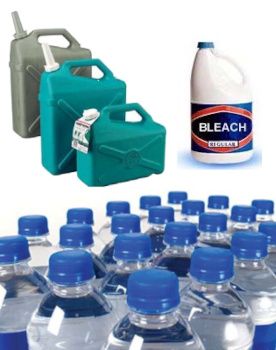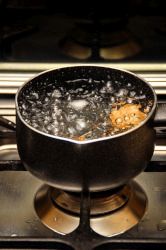Planning for your emergency water supply
In an emergency, having a supply of clean water for drinking, cooking, and hygiene is vitally important. If a natural or man-made disaster strikes your community, you might temporarily lose access to clean water so it is necessary to include water in your emergency supplies kit.
What should my Emergency Preparedness kit include to address my drinking water needs?

- Water: bottled water, tap water or some other source of clean drinking water.
- Food-grade container to store water (if not using bottled water).
- Unscented liquid household chlorine (5-6%) bleach to sanitize water storage container (if not using bottled water).
You should also include supplies and instructions for emergency water treatment in case you run out of your stored water. There are several methods for treating you water so be sure to include the items needed for the method you plan to use.
- Boiling water
- Supplies to boil water (ex: camp stove, fuel, etc.).
- Disinfection
- Unscented liquid household chlorine (5-6%) bleach.
- Filtration
- Portable water filtration unit, typically available at sporting good stores or anywhere that carries camping supplies.
How much water do I need?
You should store at least one gallon of water per person, per day for a minimum of five days. However, individual needs vary depending on age, health, physical condition, activity, diet, and climate.
To determine your water needs take the following into account:
- Children, nursing mothers, and ill individuals may need more water.
- A medical emergency might require additional water.
- If you live in warm weather climate more water may be necessary. In very hot temperatures, water needs can double.
- Be sure to account for pets; dogs and cats typically need 1 gallon each per day.
How should I store water?
 Carefully storing your water is an important part in keeping your water safe to drink.
Carefully storing your water is an important part in keeping your water safe to drink.
- Observe the expiration date for store-bought water; replace other stored water every six months.
- For bottled water keep it in its original container and do not open until you need to use it.
- For tap water you have stored in containers, clearly label container as “drinking water” and include storage date.
- Keep stored water in a location with cool temperatures.
- Do not store containers in direct sunlight.
- Do not store water containers in areas where toxic substances such as gasoline or pesticides are present.
Water Containers - Keep your clean water clean!
If you are not using commercially bottled water for your emergency preparedness kit use food-grade water storage containers (such as those found at camping supply stores).
Before filling with safe water, use these steps to clean and sanitize storage containers:
- Wash the storage container with dishwashing soap and water and rinse completely with clean water.
- Sanitize the container by adding a solution made by mixing 1 teaspoon of unscented liquid household chlorine bleach in one quart of water.
- Cover the container and shake it well so that the sanitizing bleach solution touches all inside surfaces of the container.
- Wait at least 30 seconds and then pour the sanitizing solution out of the container.
- Let the empty sanitized container air-dry before use OR rinse the empty container with clean, safe water that already is available.
Avoid using the following containers to store safe water:
- Containers that cannot be sealed tightly
- Containers that can break, such as glass bottles
- Containers that have ever been used for any toxic solid or liquid chemicals (includes old bleach containers)
- Plastic or cardboard bottles, jugs, and containers used for milk or fruit juices
Finding an emergency water source
If you run out of your stored safe drinking water and there are no other reliable clean water sources, it may become necessary in an emergency to treat water so it is safe to use. Treat all water of uncertain quality before using it for drinking, food washing or preparation, washing dishes, brushing teeth or making ice. In addition to having a bad odor and taste, contaminated water can contain microorganisms that can cause diseases. Water can be made safe to drink by boiling, adding disinfectants, or filtering.
IMPORTANT: Water contaminated with fuel or toxic chemicals will not be made safe by boiling or disinfections. Use a different source of water if you know or suspect that water might be contaminated with fuel or toxic chemicals.
Inside the Home
- Melted ice cubes made with water that was not contaminated.
- Liquid from canned fruit and vegetables.
- Water from your home’s water heater tank. To use this water be sure the electricity or gas is off and open the drain at the bottom of the tank. Start the water flowing by turning off the water intake value at the tank and turning on the hot‐water faucet. After you are notified that clean water has been restored, you will need to refill the tank before turning on the gas or electricity back on. If the gas is turned off, a professional will be needed to turn it back on.
- If you receive advanced notice of a potential disaster (ex: weather event) you can fill bathtubs and/or sinks (avoid utility sinks) prior to the event as an emergency source if your stored water supply runs out.
Listen to reports from local officials for advice on water precautions in your home. It may be necessary to shut off the main water valve to your home to prevent contaminants from entering your piping system.
Outside the Home
Water from sources outside the home must be treated.
- Rainwater
- Streams, rivers, and other moving bodies of water
- Ponds and lakes
- Natural springs
DO NOT DRINK water that has an unusual odor or color, or that you know or suspect might be contaminated with fuel or toxic chemicals; use a different source of water.
Unsafe Sources
- Radiators, hot water boilers (home heating systems).
- Water from toilet bowl.
- Water beds. Fungicides added to the water or chemicals in the vinyl may make water unsafe to use.
- Swimming pools and spas. Chemicals used to kill germs are too concentrated for safe drinking but can be used for personal hygiene, cleaning and related uses.
Emergency Treatment of Drinking Water
Once you’ve selected your source of water you will need to treat it before using it for drinking, food washing or preparation, washing dishes, brushing teeth or making ice. Water can be made safe to drink by boiling, adding disinfectants, or filtering.
IMPORTANT: Water contaminated with fuel or toxic chemicals will not be made safe by boiling or disinfections. Use a different source of water if you know or suspect that water might be contaminated with fuel or toxic chemicals.
Boiling
 If you don’t have safe bottled water, you should boil water to make it safe. Boiling is the surest method to make water safer to drink by killing disease-causing organisms, including viruses, bacteria, and parasites.
If you don’t have safe bottled water, you should boil water to make it safe. Boiling is the surest method to make water safer to drink by killing disease-causing organisms, including viruses, bacteria, and parasites.You can improve the flat taste of boiled water by pouring it from one container to another and then allowing it to stand for a few hours, OR by adding a pinch of salt for each quart or liter of boiled water.
If the water is cloudy...
- Filter it through a clean cloth, paper towel, or coffee filter
- OR allow it to settle, then draw off the clear water.
- Bring the clear water to a rolling boil for one minute (at elevations above 6,500 feet, boil for three minutes).
- Let the boiled water cool.
- Store the boiled water in clean sanitized containers with tight covers.
If the water is clear,
- Bring the clear water to a rolling boil for one minute (at elevations above 6,500 feet, boil for three minutes).
- Let the boiled water cool.
- Store the boiled water in clean sanitized containers with tight covers.
Disinfectants
 If you don’t have safe water and if boiling is not possible, you often can make water safe to drink by using a disinfectant such as unscented household chlorine bleach or iodine. These can kill most harmful organisms, such as viruses and bacteria, but are not as effective in controlling more resistant organisms such as the parasites Cryptosporidium and Giardia.
If you don’t have safe water and if boiling is not possible, you often can make water safe to drink by using a disinfectant such as unscented household chlorine bleach or iodine. These can kill most harmful organisms, such as viruses and bacteria, but are not as effective in controlling more resistant organisms such as the parasites Cryptosporidium and Giardia.To disinfect water...
- Filter it through a clean cloth, paper towel, or coffee filter
- OR allow it to settle. Draw off the clear water.
- To use bleach, add 1/8 teaspoon (or 8 drops; about 0.625 milliliters) of unscented liquid household chlorine (5-6%) bleach for each gallon of clear water (or 2 drops of bleach for each liter or each quart of water),
- Stir the mixture well.
- Let it stand for 30 minutes or longer before you use it.
- Store the disinfected water in clean sanitized containers with tight covers.
- To use iodine, follow the manufacturer’s instructions.
- Chlorine dioxide tablets are another disinfectant that now is available in some outdoor stores. This disinfectant has proven to be effective against pathogens, if the manufacturer’s instructions are followed.
Filters
 Many portable water filters can remove disease-causing parasites such as Cryptosporidium and Giardia from drinking water. If you are choosing a portable water filter, try to pick one that has a filter pore size small enough to remove both bacteria and parasites. Most portable water filters do not remove viruses.
Many portable water filters can remove disease-causing parasites such as Cryptosporidium and Giardia from drinking water. If you are choosing a portable water filter, try to pick one that has a filter pore size small enough to remove both bacteria and parasites. Most portable water filters do not remove viruses.Carefully read and follow the manufacturer’s instructions for the water filter you intend to use. After filtering, add a disinfectant such as iodine, chlorine, or chlorine dioxide to the filtered water to kill any viruses and remaining bacteria.
Other considerations
- Allow people to drink according to their needs – many people need even more than the average of one gallon per day. The individual amount needed depends on age, physical activity, physical condition and time of year.
- Never ration drinking water unless ordered to do so by authorities – drink the amount you need today and try to find more for tomorrow. Under no circumstances should a person drink less than one quart (4 cups) of water each day. You can minimize the amount of water your body needs by reducing activity and staying cool.
- Do not drink carbonated beverages instead of drinking water. Carbonated beverages do not meet drinking water requirements. Caffeinated drinks and alcohol dehydrate the body, which increases the need for drinking water.
- Learn where the water intake valve to your home is. If you hear reports of broken water or sewage lines, you’ll need to shut off water to your house to avoid letting contaminated water enter your home. Listen to local warnings for more instructions. Be sure you and your family members know how to perform this important procedure.

 Indicates an external site.
Indicates an external site.